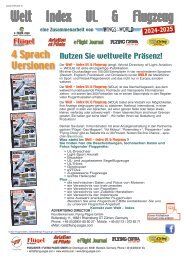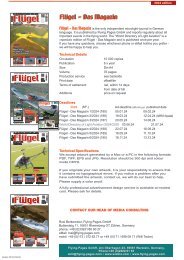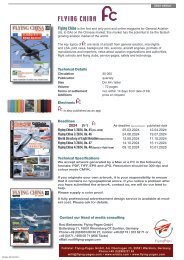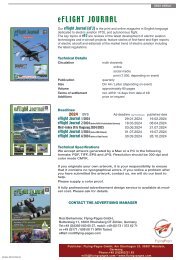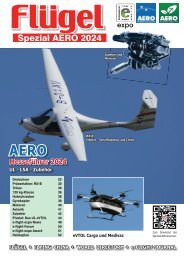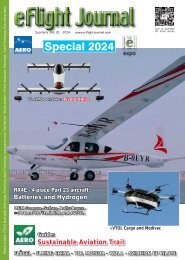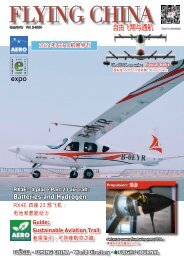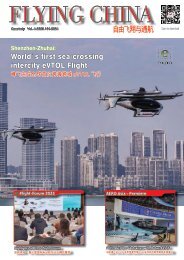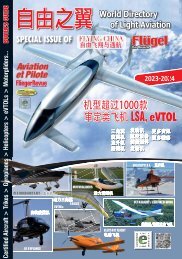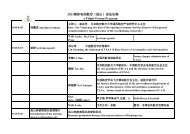You also want an ePaper? Increase the reach of your titles
YUMPU automatically turns print PDFs into web optimized ePapers that Google loves.
Market Watch<br />
A3<br />
Vahana is a full-electric VTOL vehicle designed by A3 based in Santa Clara, California. The venture capital company<br />
A3 is founded in 2015 by Airbus Group as an innovation outpost in Silicon Valley. Vahana is a tandem tiltwing<br />
aircraft, where four variable-speed, variable-pitch propellers are mounted both on the forward and the main wing.<br />
The propellers and the wings tilt up during vertical takeoff and tilt horizontal for cruise <strong>flight</strong>. The demonstrator uses<br />
45-kW motors and Lithium Polymer batteries. The current version of Vahana is a single-seater designed for autonomous<br />
ride-sharing or air taxi services. The first fully autonomous <strong>flight</strong>s will be performed before end of <strong>2017</strong>. Yet it<br />
is planned for 2020 to have a certifiable and producible vehicle with two seats.<br />
VAHANA<br />
A3 AIRBUS 3000 Sand Hill Road - 1-120 • Menlo Park 94025 • California • USA • Phone : +1 703 889-0535<br />
hello@airbus-sv.comm • www.airbus-sv.com<br />
EW MTOW PA BA PD Engine Power St Vmax Vc Vz ES Endurance Price (estimate) Kit Plan<br />
725 8 2 8x45 kW 360 kW 1 173 1/2h - -<br />
AURORA FLIGHT SCIENCE<br />
At the Uber Elevate Summit in April <strong>2017</strong>, Aurora Flight Science unveiled its two-seat eVTOL air vehicle concept for<br />
Uber’s flying taxi service. Aurora Flight Science has more than 20 years of experience in developing special-purpose<br />
unmanned aerial vehicle (more than 30 unmanned aircraft developed). For this aircraft, Aurora’s design logic was to<br />
keep the architecture simple and emphasizes the cruise efficiency. For this reason, its eVTOL aircraft features eight<br />
lift propellers distributed along two booms for the vertical takeoff, while a single pusher propeller delivers the propulsion<br />
for the horizontal <strong>flight</strong>. For the cruise <strong>flight</strong>, the lift propellers will be stopped and the lift is generated by three<br />
aerodynamic surfaces, i.e. the canard, wing and tail. Even the aircraft is designed for fully autonomous <strong>flight</strong>s, the<br />
two-seater can provide place for a safety pilot due to current certification constraints. The first full-scale <strong>flight</strong> tests of<br />
the aircraft are scheduled to 2020 in Dallas and Dubai.<br />
AURORA FLIGHT SCIENCE CORPORATION 9950 Wakeman Drive • Manassas, Virginia 20110 • USA •<br />
Phone : +1 703 369 3633<br />
info@aurora.aero • http://www.aurora.aero<br />
AURORA FLIGHT SCIENCE 1<br />
EW MTOW PA BA PD Engine Power St Vmax Vc Vz ES Endurance Price (estimate) Kit Plan<br />
- - 8 + 1 2 - - 2 - - - - - - - -<br />
E-VOLO<br />
The VC200 made by the e-volo team in Germany had its unmanned maiden <strong>flight</strong> on November 17, 2013, and its<br />
first manned <strong>flight</strong> in March 2016. It is a world exclusive design, and so far the only two-seat multicopter. It is a sideby-side<br />
450kg MTOW ultralight ‘volocopter’ with 18 electric motors and 18 rotors with each rotor 1.8 m in diameter.<br />
It comes with fly-by-wire technology, and is a fully carbon built aircraft. The rotor arms are detachable for transport<br />
and hangar storage. In <strong>2017</strong>, e-volo signed an agreement with Dubai’s transport authority to begin testing VC200<br />
as part of a flying taxi service in the fourth quarter of <strong>2017</strong>.<br />
VC200<br />
E-VOLO GMBH Oestliche Rheinbrueckenstr. 50 • 76187 Karlsruhe • GERMANY • Phone : +49 (0)721 754 000-0, Fax : +49<br />
(0)721 754 000-99<br />
info@volocopter.com • www.e-volo.com<br />
EW MTOW PA BA PD Engine Power St Vmax Vc Vz ES Endurance Price (estimate) Kit Plan<br />
290 450 18 2 1.8 18x3 kW 54 kW 2 100 50 17.5 kWh 30 min - -<br />
EHANG INC.<br />
The EHang 184 is an Autonomous Aerial Vehicle (AAV) designed by Guangzhou EHang Inc. and it was first shown<br />
to the public on CES 2016. The designator “184” stands for “1 passenger, 8 propellers, and 4 arms”. The EHang<br />
184 has eight unducted 1.6 m diameter propellers arranged in a quadcopter configuration, where two counter-rotating<br />
propellers are mounted on each of the four so called “propulsion arms”. According to the manufacturer, the<br />
empty weight of EHang 184 is about 240 kg and a maximum gross takeoff weight is 360 kg. The lithium polymer<br />
batteries enable the drone a cruise speed of 60 km/h and an endurance of about 30 minutes. Currently, EHang<br />
184 is performing test <strong>flight</strong>s in Dubei and Nevada (USA).<br />
EHANG 184<br />
EHANG INC. Building No.3 of Yixiang Science Park,No.72 • 510700 Huangpu District, Guangzhou Guangdong •<br />
Guangdong • CHINA • Phone : +86 020-29028899<br />
service@ehang.com • www.ehang.com<br />
EW MTOW PA BA PD Engine Power St Vmax Vc Vz ES Endurance Price (estimate) Kit Plan<br />
240 360 8 2 1.6 8x19 kW 152 kW 1 60 17 kWh 30 - -<br />
e Flight Journal<br />
42



